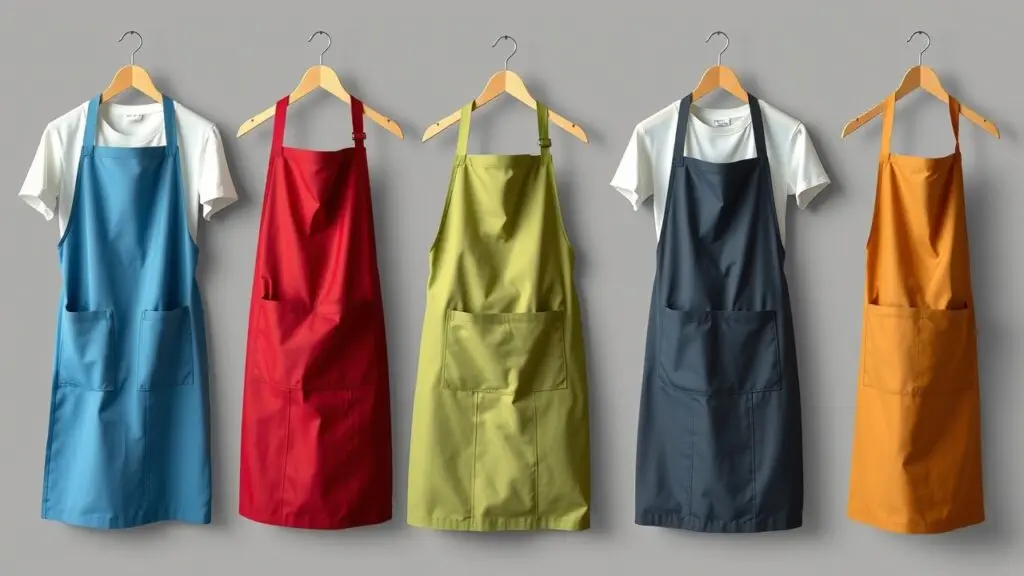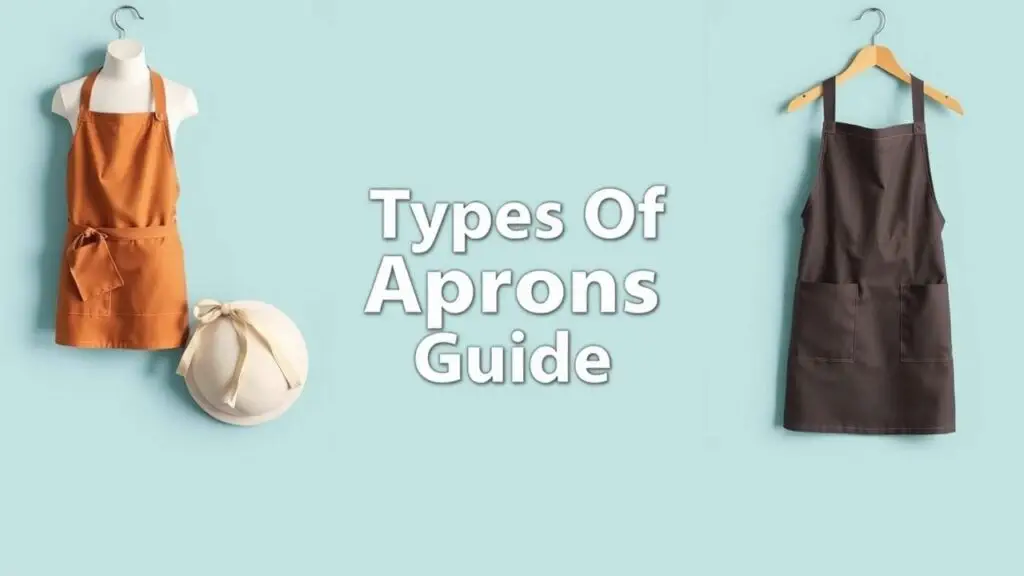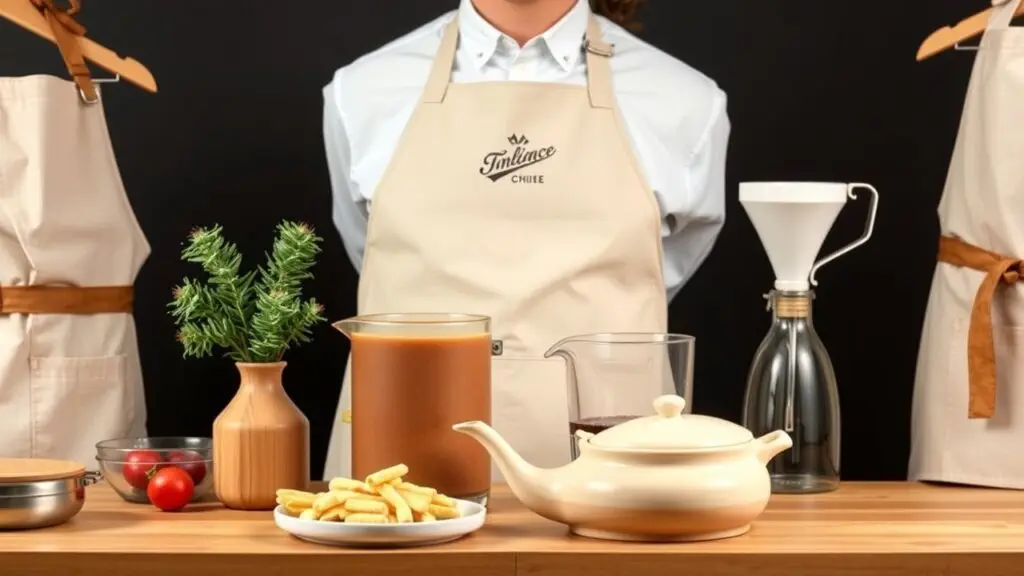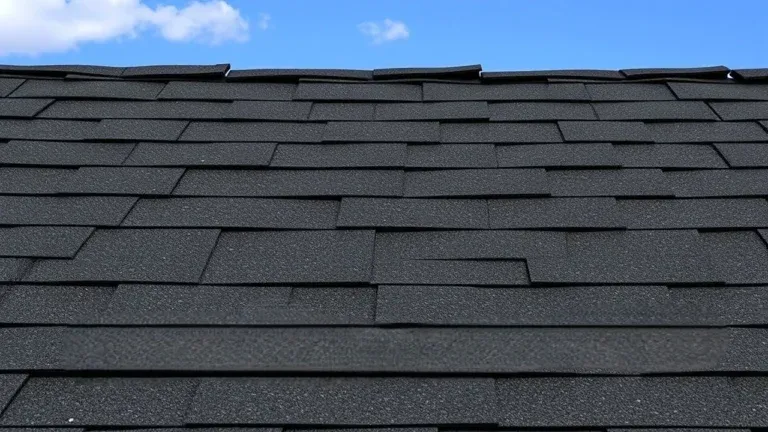Learn about various types of aprons, from bib and chef aprons to waist aprons, and find the perfect one for your needs. This guide covers materials, styles, and uses.
What Is an Apron and Why Do You Need One?

Aprons are protective garments worn in front of your clothes. They help keep your clothing clean while you cook, craft, or work. Their main job is to protect from spills, stains, and debris. Picking the right apron can really affect how comfortable and useful it is for the task you’re doing.
Different jobs use different types of aprons. For instance, chefs often wear full aprons that cover a lot of their clothing and have pockets for tools. Artists might choose smock-style or painter’s aprons. These designs let them move easily while keeping them safe from paint splatters.
Benefits of Wearing an Apron
Wearing an apron has some good points:
- Protection: Keeps your clothes safe from food messes, paint, and other stains.
- Convenience: Many aprons come with pockets for easy carrying of tools or ingredients.
- Comfort: A good apron fits well and allows movement without restriction.
- Professional Appearance: Wearing the right apron can make you look more professional in kitchens or craft shows.
Choosing the right type of apron not only keeps your clothes clean but also makes tasks easier.
Importance of Choosing the Right Apron for Different Tasks
Choosing the right apron matters a lot based on what you need it for. A good apron helps you work better by keeping you protected without limiting your movements. Key factors to look at are the material—like cotton or denim—and whether it has adjustable straps to fit comfortably.
Key Features to Look For:
- Material Durability: Heavy-duty fabrics like canvas or blends are great for tough jobs; lighter fabrics like cotton are better for simple tasks.
- Adjustable Straps: Straps that can be adjusted help make sure the apron fits nicely no matter your body shape.
- Length Options: Full aprons give more coverage than half aprons; think about which fits your activities best.
Understanding these features helps you pick the best apron for cooking in the kitchen or creating art at home.
Brief Overview of How Aprons Are Used Across Industries
Aprons find uses in many areas, like culinary arts where chefs need special designs like bibs or waist server styles; crafting where artist smocks are useful; heavy-duty work environments needing welding or butcher aprons; and gardening where pockets help carry tools.
| Industry | Common Types | Purpose |
|---|---|---|
| Culinary Arts | Chef & Bistro | Protects clothing while cooking |
| Crafting | Artist Smocks | Allows freedom of movement |
| Industrial | Butcher & Welding | Provides safety against hazardous materials |
| Gardening | Utility | Offers storage space while working outdoors |
Every context needs special styles, from classic looks to trendy designs, to match both what looks good and what works well in practice.
What Are the Different Styles of Aprons?
Aprons come in many styles, each made for different tasks. Knowing about the types of aprons can help you pick the best one for cooking, baking, or crafting.
Bib Apron
Bib aprons offer full-body coverage. They usually stretch from the chest down to the knees or even lower. This design protects against spills and splatters very well. Bib aprons often have adjustable neck straps and long waist ties. They’re great for cooking and painting since they keep your clothes clean. Some also have pockets for holding utensils or tools.
Cross-back Apron
The cross-back apron has straps that cross at the back instead of tying around the neck. This setup makes it comfortable to wear because it spreads the weight evenly across both shoulders. Many styles come with adjustable straps to fit just right. Chefs and crafters like cross-back aprons because they allow easy movement while being durable.
Waist/Server/Bistro Apron
Waist aprons are shorter than bibs and cover only from the waist down to mid-thigh or knee level. They usually have pockets on either side, which make it easy to grab tools or ingredients while cooking or working in restaurants. They work well as server uniforms too! Bistro-style waist aprons are lightweight, so they allow freedom of movement without losing functionality.
Pinafore Style Apron
Pinafore style aprons mix fashion and function. They look like dresses with open backs but provide a lot of coverage where messes happen most—like when you’re cooking or gardening! You can find them in various styles, from simple cotton prints to fancier designs with ruffles, which make them appealing for casual wear.
Smock Style/Artist’s Apron
An artist’s smock is designed for painters and crafters who need extra protection against paint splashes and other messy materials! These smocks are typically loose-fitting and made from durable fabrics that can withstand many washings without losing shape. Features may include large pockets for brushes or tools that keep everything within reach while working on your next masterpiece!
Understanding these different styles helps you choose an apron that fits your activities—whether you’re whipping up dinner in your kitchen, creating art in your home studio, or serving customers efficiently in a restaurant!
Which Specialized Designs Are Available Based on Profession?
When picking the right apron, it’s key to know that different designs are made for different jobs. Each type helps you stay safe and do your tasks better.
Chef Aprons
Chef aprons are a must-have in any kitchen, whether you’re cooking at home or working in a restaurant. These kitchen aprons are often made from tough materials that handle spills and stains well. Many chef aprons have pockets for easy access to tools like spoons and thermometers. They cover your clothes fully, keeping you safe from hot splashes or sharp items while making sure you feel comfortable during long cooking hours.
Butcher Aprons
Butcher aprons are built for heavy use. They’re made from strong materials that can resist cuts and scrapes. These industrial-grade protective clothing pieces offer great coverage against meat juices and other substances in butcher shops. Butcher aprons usually come with adjustable straps for a secure fit and often have reinforced stitching for extra durability.
Dental Aprons
In dental offices, hygiene is super important. Dental aprons are made from hygienic materials that can be cleaned easily. Medical professionals wear these medical aprons during procedures to keep themselves and their patients safe from germs. Most dental aprons have a waterproof layer that helps keep clothes dry while being light enough to move around comfortably.
Welding Aprons
Welding involves safety gear that can handle extreme heat and sparks from welding tools. Welding aprons are made from flame-resistant materials that protect your body during metalwork tasks. These heat-resistant garments cover important areas like arms and torso while still letting you move freely with your tools.
Lab Coats (as Aprons)
Lab coats are not just for labs; they work like protective clothing similar to traditional lab aprons by shielding against spills of chemicals or biological agents in scientific environments. Lab coats used as aprons help researchers stay clean while handling sensitive samples or hazardous materials. They typically have pockets for holding pens or small instruments needed during experiments.
Choosing the right apron design is important for each profession’s needs. Make sure to pick the one that fits your job best!
Choosing the Right Apron Material
When you pick an apron, the material matters a lot. It can change how comfy, strong, and useful the apron is. Different types of apron fabric fit different needs, so knowing what each type offers can help you choose the best one for you.
Cotton
Cotton aprons are a fan favorite because they breathe well and soak up spills. This fabric works great for kitchen tasks and light jobs where messes might happen. Plus, cotton feels soft against your skin, making it comfy for long wear. To keep it looking good, just toss it in the washing machine with cold water.
Linen
Linen is super durable and breathable. It’s perfect for professional spots like restaurants or even stylish home use. Linen doesn’t wrinkle easily, which keeps you looking sharp without too much effort. To take care of linen aprons, hand wash them gently or send them to dry cleaning.
Denim
Denim aprons are tough and built to last. They’re perfect for heavy-duty work like woodworking or gardening where things get messy. Denim holds up against dirt and stains very well. To clean denim aprons, machine wash them with similar colors to avoid fading.
Canvas
Canvas aprons are strong and even have some water resistance! They work well for outdoor tasks like gardening or grilling where spills are common. Their thick fabric adds extra protection too. Just spot clean them regularly to keep them in good shape.
Leather
Leather aprons are known for their toughness and water resistance. These aprons are often used in industrial settings where safety is key—think heat or sharp tools! Keeping leather nice means using special cleaners that won’t harm it.
Waterproof/Water-Resistant Materials
If you’re dealing with messy tasks, waterproof materials like vinyl are lifesavers! They make cleanup easy and work great in places like food service or crafting. Coated cotton options also protect against spills while being light enough for daily use. For cleaning these materials, simply wipe them down instead of washing them fully to keep their protective features intact.
In choosing from these apron fabrics—cotton, linen, denim, canvas, leather—and waterproof options—you’ll find one that suits your needs whether you’re cooking at home or working in a professional environment.
Essential Features to Look For

When picking an apron, knowing the important features can make a big difference in your cooking, baking, or crafting. Here are some key things to think about:
Length and Coverage
The length of an apron really matters for how much protection it gives. Full-length aprons cover your whole body, making them great for messy jobs in the kitchen or while crafting. Long bib aprons go down to your knees or lower, offering good protection but still letting you move freely. Short aprons only cover your waist and are perfect for lighter tasks where you don’t need much coverage.
Straps and Adjustability
Comfort is super important if you’re wearing an apron for a long time. Look for adjustable straps that fit different body types well. Cross-back straps help spread out the weight on your shoulders, making it easier to wear for hours. Neck strap adjustments let you get a secure fit, so your apron stays in place without causing any pain.
Pockets
Pockets are super handy when using aprons in kitchens or craft areas. Multi-pocketed designs let you store tools like spatulas or scissors easily and keep them close while you’re busy. Think about the size and placement; bigger pockets can hold more but might be awkward if they aren’t positioned right.
Durability
The type of material affects how long your apron lasts, especially in tough settings where heavy-duty materials are needed for strength against wear and tear from washing or exposure to harsh stuff.
Style and Aesthetics
Your choice of style matters too! Pick an apron that fits well with your work area and reflects your personal taste while considering color options as well. There are many choices from trendy designer aprons to classic looks that suit traditional kitchens—choosing one that feels good can make wearing it more fun every day.
By focusing on these main features—length & coverage; straps & adjustability; pockets; durability; style & aesthetics—you’ll have a better chance at finding the right apron among all the options out there today.
Finding the Right Apron for the Job
Choosing an apron can really make your cooking, baking, crafting, or gardening more fun. There are lots of types to pick from. Knowing what each one does will help you decide which is best for you.
Kitchen Aprons
Kitchen aprons help keep your clothes clean while cooking. Most of them are made from cotton because it’s comfy and easy to wash. A full-length apron covers you well if you’re messy in the kitchen. Look for a chef’s apron with adjustable straps for a better fit.
Key Features:
- Cotton Kitchen Apron: Soft and great at soaking up spills.
- Full-Length Apron: Covers most of your clothes from splashes.
- Adjustable Straps: Make sure it fits everyone comfortably.
Baking Aprons
When you’re baking, having the right apron is super important. It keeps flour dust and messes at bay. Find aprons made from flour-resistant materials so stains don’t stick. Also, heat-resistant fabric is good if you’re near hot stuff.
Baker’s Features:
- Flour-resistant fabrics stop messes during baking.
- Heat-resistant material helps protect against burns.
Crafting Aprons
Crafters need aprons that protect their clothes and hold tools. An artist’s apron usually has pockets to keep brushes or small things handy. The smock style gives plenty of room to move, which is great when you’re painting or working on crafts.
Crafting Essentials:
- Artist’s aprons have pockets just for tools.
- Smock-style designs allow freedom and protect against spills.
Gardening Aprons
Gardening can get dirty, so a garden apron is helpful to keep tools close while saving your clothes from dirt. Look for ones with pockets that can hold trowels or gloves easily. Also, water-resistant fabric helps keep you dry on wet days.
Gardening Features:
- Pockets made for holding gardening tools safe.
- Water-resistant material keeps you dry even when it rains.
Restaurant/Bar Aprons
In busy places like restaurants or bars, durability matters a lot. A waiter’s apron should have useful features like deep pockets for holding order pads and pens. Bistro-style options mix function with style—perfect whether you’re serving food or making drinks.
Professional Characteristics:
- Waiter’s apron’s design has pockets where they need them.
- Bistro-style durability lasts through everyday use.
Choosing the right apron makes tasks like cooking or gardening easier and more enjoyable! With so many styles available, you’ll find one that fits your needs just right!
Keeping Your Apron Clean and in Good Condition

Keeping your apron clean is super important. It helps maintain hygiene and ensures your apron lasts longer. Whether you’re using a durable kitchen apron or a stylish baking one, proper care is key. Let’s look at how to keep your apron looking great.
Cleaning Instructions for Various Materials
Different types of aprons need different cleaning methods:
- Cotton Aprons: You can toss these in the washing machine. Use a gentle cycle with cold water and mild detergent to keep the colors bright.
- Linen Aprons: Hand wash them in cool water or use a delicate cycle in the machine. Avoid bleach. For tough stains, try natural stain removers.
- Denim Aprons: These aprons are usually safe for the washing machine. Wash them inside out with cold water to prevent fading. Skip the fabric softener.
- Canvas Aprons: Check the label, but they typically can go in the washing machine too. Wash in cold water and with similar colors.
- Leather Aprons: Never soak leather aprons! Just wipe them down with a damp cloth after each use, and apply leather conditioner from time to time.
- Waterproof Aprons: Wipe them clean with a damp cloth or sponge since most can’t handle high heat from washing machines.
Stain Removal Tips
Stains happen, especially while cooking or crafting. Here are some tips to tackle them based on apron material:
For cotton aprons stained by food like tomato sauce:
1. Blot the stain with a paper towel right away. Don’t rub it; that could make it worse!
2. Pre-treat it with liquid laundry detergent before washing.
For linen aprons:
1. Rinse under cold running water immediately to remove excess residue.
2. For stubborn stains like wine, soak it in vinegar mixed with warm water before laundering.
Denim aprons may get tough stains like ink:
1. Apply rubbing alcohol on the ink spot using a cotton ball until it lifts away, then wash normally.
Canvas aprons are great for oil-based stains:
1. Make a paste with baking soda and water, apply it to the stain, let it sit for 30 minutes, then rinse off well.
Waterproof fabrics resist stains but might need some care if dirt builds up:
1. Wipe down any dirt with soapy warm water, then rinse off all soap residues completely.
Proper Storage Methods
How you store your apron matters too:
Hanging an apron lets air circulate around it. This helps avoid mustiness and keeps wrinkles away—perfect for heavy aprons like bistro ones that should be hung neatly near where you cook.
Folding is good for lighter options like half-aprons used during casual cooking sessions at home. This saves space and protects them from dust when stored in drawers or cabinets dedicated to kitchen textiles.
Both methods have their pros: hanging keeps your aprons ready without creasing while folding saves storage space.
Minor Repair Techniques
Fixing small issues can help your apron last longer:
To sew up small tears:
1. Grab a needle and thread that matches your fabric color closely.
2. Turn the apron inside out and line up the torn edges together using pins.
3. Stitch straight across the tear, ensuring it stays tight until you finish sewing so it looks neat!
For replacing buttons:
1. Carefully remove the old button using scissors’ tip underneath until it’s loose enough to detach.
2. Place the new button where you want it and align its holes over the fabric layer below, securing tightly by threading through all layers several times for a strong hold.
Taking care of your apron doesn’t have to be hard! By following these tips, you can keep it clean, stylish, and ready for all your cooking adventures!
Frequently Asked Questions (FAQs) About Types of Aprons
What are the different types of aprons?
Aprons come in many styles, such as bib, waist, and cross-back aprons. Each type serves unique purposes for cooking, crafting, or professional use.
Which apron is best for cooking?
Full-length chef aprons are ideal for cooking. They provide maximum coverage and often include pockets for tools.
What is a butcher apron used for?
Butcher aprons are designed for heavy-duty tasks. They protect against cuts and stains in meat processing.
How do I choose an apron for crafting?
For crafting, select an artist’s or smock-style apron. These designs offer freedom of movement and often have large pockets.
What materials are best for aprons?
Cotton and denim are popular choices. They are comfortable, durable, and easy to clean.
Additional Unique Content on Apron Types
Specialty Apron Styles
- Tuxedo Aprons: Perfect for formal occasions and serving events.
- Shoemaker Aprons: Designed for durability in shoe-making.
- Dishwasher Aprons: Waterproof styles to protect against spills.
- Woodworking Aprons: Heavy-duty with tool pockets to assist craftsmen.
- Hooded Aprons: Provide extra protection from messes during work.
Varieties Based on Function
- Barista Aprons: Feature pockets for coffee tools and utensils.
- Medical Aprons: Used in healthcare settings to maintain hygiene.
- Welding and Flame-Resistant Aprons: Protect against sparks and heat in metalwork.
- Nursing and Dental Hygienist’s Aprons: Help maintain cleanliness while working with patients.
- Mechanic’s Apron: Offer durable protection from oil and grime while fixing vehicles.
Buying Tips
- Look for adjustable straps to ensure comfort.
- Choose aprons with ample pockets for convenience.
- Consider waterproof options if you often deal with spills or wet tasks.
- Select heavy-duty materials if you’re involved in laborious projects like grilling or woodworking.
Related Topics
- types of apron materials
- types of apron straps
- types of apron pockets
- types of apron lengths
- types of apron styles
- types of professional aprons
- types of apron cleaning methods
- types of apron stains
- types of apron storage methods
- types of apron repairs



Types of Aprons: A Complete Guide